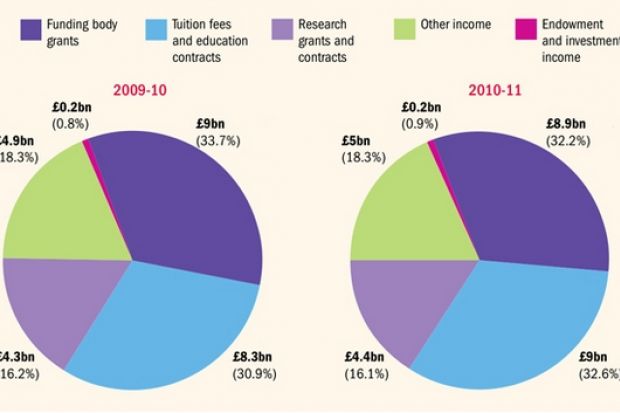England's funding council believes university mergers and collaborations could bring "greater efficiency and effectiveness" as the body's former head predicted that more universities would be forced together by financial pressure.
The Higher Education Funding Council for England acknowledged the scope for link-ups in a guidance report for universities, Collaborations, Alliances and Mergers in Higher Education, published on 13 March.
Collaborations, alliances and mergers (CAM) activity "could strengthen research in the face of national and international competition, and improve (universities') position in the rankings", it notes.
"Partnership with the private sector might be one means of making better use of new ICT or enhancing the student experience more broadly," the report adds.
"Institutions with a strong commitment to widening access and effective outreach programmes might become useful partners for other institutions that have less experience in these areas."
In his foreword to the report, Hefce chief executive Sir Alan Langlands says: "We believe CAM activity might well continue to be part of the sector's response to change and is likely to provide opportunities for greater efficiency and effectiveness, but regard this as a matter for institutions".
But the report also notes "the tendency to underestimate costs and risks" in CAM activity. It also seems to have caused division within Hefce, as minutes from a December board meeting cite concerns over "whether it is appropriate to publish the report and consultation".
The minutes say some members "suggested that Hefce's role as student champion will likely mean that Hefce will have a role in challenging the assumptions behind CAM activity ... to protect the interests of prospective, current and past students".
Publication of the report came as David Eastwood, University of Birmingham vice-chancellor and former Hefce chief executive, gave his view on the sector's future as the collaboration between his institution and the University of Nottingham marked its first anniversary.
Professor Eastwood told Times Higher Education that while Nottingham and Birmingham each had annual turnovers of around £500 million and were "financially strong", there were universities with £30 million to £50 million turnovers "having to carry a lot of the same infrastructure costs that we do".
"If we can see some issues from a combined operation of almost £1 billion, you would expect others to be in search - rather urgently - of those kinds of efficiencies."
In their year of collaboration, Nottingham and Birmingham have jointly appointed an international officer to boost student recruitment in Brazil and established a £480,000 joint investment fund for research partnerships with institutions in Sao Paulo state. At home, they shared research equipment and won a share of £5 million to set up one of two national centres for ageing and pain research funded by the Medical Research Council and Arthritis Research UK.
Professor Eastwood said the collaboration had stimulated "a lot of interest both in the sector and in government. What we are doing will remain relatively rare, because it is relatively rare to have two big universities, financially strong, which over a period have built good relations. There will be other issues that move other institutions to alignments and mergers."
Nottingham and Birmingham "have their own identities...and are not going to do anything that undermines that", he added.
Nottingham vice-chancellor David Greenaway put the collaboration in the context of "diversifying research income streams - which is important to do in the current climate", arguing that "there are resources out there, especially in the big emerging economies".
Professor Greenaway said of the joint MRC funding: "I don't think that would have happened without the collaboration. We probably would have ended up putting in competing bids - neither bid would have been big enough, strong enough, in its own right."
He also highlighted the potential for the two universities to work together in pre-university education on "changing life opportunities in [the] two cities".
From students to paymasters? UK universities' income by source
It is still six months before the first students to pay £9,000 a year in tuition fees begin their studies, but figures show that the balance has already tipped away from funding grants as the most important source of the UK sector's income.
According to data released last week by the Higher Education Statistics Agency, fees and education contracts accounted for 32.6 per cent of universities' income in 2010-11, up from 30.9 per cent in the previous year.
Funding body grants, meanwhile, shrank by £100 million between the 2009-10 and 2010-11 academic years, slipping to 32.2 per cent of overall income.
With teaching grants in England being slashed by up to 80 per cent over the spending review period, it is a gulf that is set to widen considerably.
Register to continue
Why register?
- Registration is free and only takes a moment
- Once registered, you can read 3 articles a month
- Sign up for our newsletter
Subscribe
Or subscribe for unlimited access to:
- Unlimited access to news, views, insights & reviews
- Digital editions
- Digital access to THE’s university and college rankings analysis
Already registered or a current subscriber? Login
